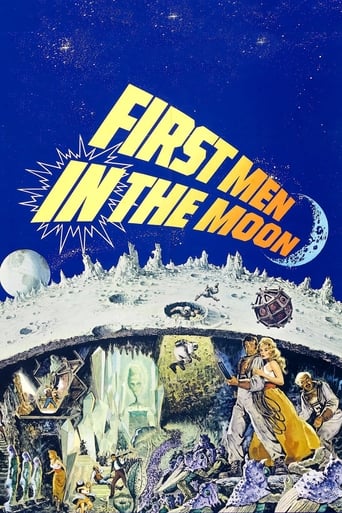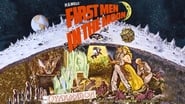Julian R. White
Wow! I'm pretty surprised. Well, I shouldn't be, good old H.G. never lets you down. Fact is, this really should be higher on the list of the most iconic science fiction of the early years. The effects are marvelous, and it's some of Harryhausen's best work in my opinion. Awesome concept, an alien race eager to learn about the humans, what their planet is like, only to become paranoid at the idea of violent humans coming to the moon. It's a bit different from most films of its time in the fact that the alien race isn't exactly the enemy of the humans. They are more so concerned and ready to defend themselves from an oncoming invasion...to the moon, from earth. Overall I could totally watch this film again, which is something I don't usually do. I would highly recommend it to anyone who truly loves science fiction.
Phil Hubbs
Or in this case the first men, and one woman, in the moon. Bit of a glaring mistake with this adaptation. Why did they alter the source material? I guess director Nathan H. Juran thought his film needed a beautiful damsel in distress angle for the wider audience.The second H.G. Wells story to feature encounters with alien lifeforms after his most famous sci-fi story The War of the Worlds. Obviously a more fantastical story from Wells and this British made film certainly has that outlandish angle that's for sure. Although it seems this film isn't as surreal or fantastical as the original story surprisingly.The whole story is narrated by the main character as an old man. It tells the story of how his eccentric inventor neighbour creates a substance that defies or eliminates gravity thus allowing them to fly to the moon in a homemade space sphere (hexagon). There on the moon they encounter insect-like aliens hungry for knowledge.Interesting to note that this film was of course made before man actually reached the lunar surface (1969). This of course doesn't mean people in 64 thought there were aliens running around up there, but back when the original story was published in 1901 I'm guessing people could of thought it possible. The whole idea that the two main characters in this film use deep sea diving gear on the lunar surface is cute.Whether or not this was an actual belief of the era or just Well's fantasy, I don't know (I'm not even sure if this is accurate with the original source material). I think its fair to say back in the early 1900's the knowledge on resources/materials required for space travel/space crafts in general was probably very limited and underestimated, so what we see in this adaptation could well have been real concepts of the time (maybe not the moon bugs though).Putting aside the real science plot holes (of which there are absolutely tonnes), the film itself is highly enjoyable. This is my first ever viewing of the film and straight away you can see many little sequences which have been homaged by other sci-fi films, mainly 'Mars Attacks'. It seems Mr Burton liked this particular sci-fi film. The big bug idea could also have spawned the likes of 'Starship Troopers', mainly the huge centipede-like insects (space cows) that roam the lunar surface.The alien creatures known as Selenites are bug-like in appearance, bipedal and live underground like ants. These guys are mainly men in rather cheap basic looking rubber suits but some of the main aliens are animated by Ray Harryhausen including the wonderful lunar centipedes.Visually the whole film is very striking offering some lovely matte paintings, sets, models, and that typically dapper Victorian attire that you see in many Wells and Verne adaptations. Even the inside of the space sphere is lined with that diamond shaped patterned leather upholstery effect. I think that concept was started by the 1960 film 'The Time Machine'. The small space flight sequences at the start of the film are a joy to behold, very dated but very effective (not too far from reality either with the flight suits); surely everyone will appreciate them.The only downside to the film for me was the bland characters. Bedford (Edward Judd) has that stereotypical male chauvinistic streak about him coming across as rather unfriendly and rude. He's always shouting at his fiance Kate who does pretty much nothing accept look pretty and shout back. Then you have the main character of Cavor played quite oddly by Lionel Jeffries. His performance was a strange one as it comes across as though he's improvising, it doesn't feel like he's in character or simply he can't act too well. His constant yelling and rather frantic red-faced performance does become tiresome.At the time this film was made, space travel and reaching the moon (the space race) was at its peak with public interest. So to go backwards and make a film so 'medieval' must have been a hard sell, despite being an adaptation. But this film is pure and utter silly fantasy (no further explanations required for that); its not a film for actors and its not really about the characters either. Its a visual spectacle, an effects film, an early 60's blockbuster if you will. Take all the gigantic scientific plot holes and complete lack of realism as part of the fun (as was intended), and you can't fail not to enjoy.
Leofwine_draca
A typical slice of British science fiction, this is an ultimate B-movie, full of awful special effects, hilarious acting, and an outlandish plot. It's a bit like THE LAND THAT TIME FORGOT, only ten years earlier and with space instead of history. Thankfully, the film also has its tongue firmly in cheek, unlike the earlier FIRST MAN INTO SPACE which was so stultifyingly serious as to be almost boring. The cast are obviously enjoying themselves a lot here, and the spirit of the thing rubs off on the viewer as well.While there are a few neat original scenes in the film, most of it simply rips off what has gone before. The theme of travel to the moon was already done 14 years earlier with DESTINATION MOON. The alien leader looks a bit like the guy from INVADERS FROM MARS, while the moment where Judd and Jeffries discover their space sphere has been dragged away through a huge door is directly ripped off from THE TIME MACHINE. If you've seen both the films, the similarities are overwhelming. There is even conflict between the heroes, as one wants to communicate with the aliens, the other destroy them, bringing to mind films like THE DAY THE EARTH STOOD STILL, which explored similar friendly/destructive issues. At the end the aliens are killed by the common cold, just like in WAR OF THE WORLDS. Is this film better than the sum of its parts? Not really, but it's a whole lot of fun anyway.Still, even if the film isn't original, there are still plenty of reasons to watch. Action is always of the utmost importance, so things don't get bogged down in scientific jargon. What science there is, about a helium liquid which protects against gravity, is totally ridiculous, yet explained in such a serious way that you almost wonder if it is in fact possible (thanks in part to Nigel Kneale, scriptwriter). You can also sit back and enjoy the many cheap, makeshift special effects in the form of rubber-suited alien dwarfs, buildings exploding, and the space craft itself, let's just say it's pretty obvious the special effects guys were 13 light years behind STAR WARS.The cast is also excellent, with only the underwritten role of Martha Hyer being disappointing (yes, all she does is scream and have to be rescued, incredibly sexist these days). The role of the square-jawed hero is played admirably by Edward Judd (ISLAND OF TERROR), an actor whose performances I've always enjoyed. However, the show is stolen by one Lionel Jeffries whose endless comic relief provides a constant source of amusement. In fact he plays his character very similar to the way Peter Cushing played Doctor Who - fussy, funny and crazy. Further down in the cast list, we have solid comic relief from Miles Malleson, while Marne Maitland, one of Hammer's favourite foreigners, appears fleetingly.There are other reasons to enjoy the film, apart from the outstanding cast. Firstly, the clever framing device which updates H G Wells' original story to contemporary times; the wraparound story makes the most of the then-current 'space race'. Secondly, some great stop motion animation work from that SFX master, Ray Harryhausen, the man responsible for some of the most memorable monsters of all time. Here, he gives us some giant killer maggots, and also some weird, spooky alien creatures. Harryhausen's work here certainly isn't his best (it may even be his worst), but it's still ahead of contemporaries. The aliens are pretty memorable in their weirdness, the effectiveness only being detracted by some brief moments of rubber suited aliens (obviously Harryhausen had neither the time nor the budget to make more than two or three stop motion aliens). These factors help to make FIRST MEN IN THE MOON, while admittedly no classic, a fun, exciting science fiction adventure in the quaintest British tradition. They just don't make films like these anymore!
BA_Harrison
Struggling entrepreneur Arnold Bedford (Edward Judd) invests in the latest invention by crackpot scientist Joseph Cavor (Lionel Jeffries): Cavorite, a substance that defies gravity. In order to test their product, the pair embark on a trip to the moon in a metal sphere, accompanied by Arnold's unwilling fiancé Kate Callendar (Martha Hyer). Once on the moon, the trio run into trouble with a race of technologically advanced bug-eyed creatures that Cavor calls Selenites.First Men In The Moon is an entertaining sci-fi yarn boasting great performances, solid direction from Nathan Juran, and some impressive visual effects (for the day), including a couple of nice Ray Harryhausen Dynamation creatures; but what I like best about the film is that it sticks steadfastly to H.G. Wells fanciful scientific invention, no matter how absurd it all gets. If the book was to be adapted for the screen these days, I have no doubt that much of the content would be drastically altered to make it seem more plausible, but in the process, Wells' story would be robbed of its innocent Victorian futurism charm.In Juran's 1964 movie, it's all intact: the crazy sphere with blinds coated in Cavorite, the massive caterpillar-like moon cows (sadly, not a thing, as we have since discovered), the weird and wonderful lunar vegetation, and the intelligent insectivorous beings (mostly realised via men in unconvincing rubber suits) who must create their own oxygen to breathe (which leaves one wondering how they evolved). The script, by Nigel Kneale, also throws in the silly idea of using deep sea diving suits as space attire, plus a near miss (of about 90 million miles) with the sun.It's all extremely daft, but therein lies the fun.





